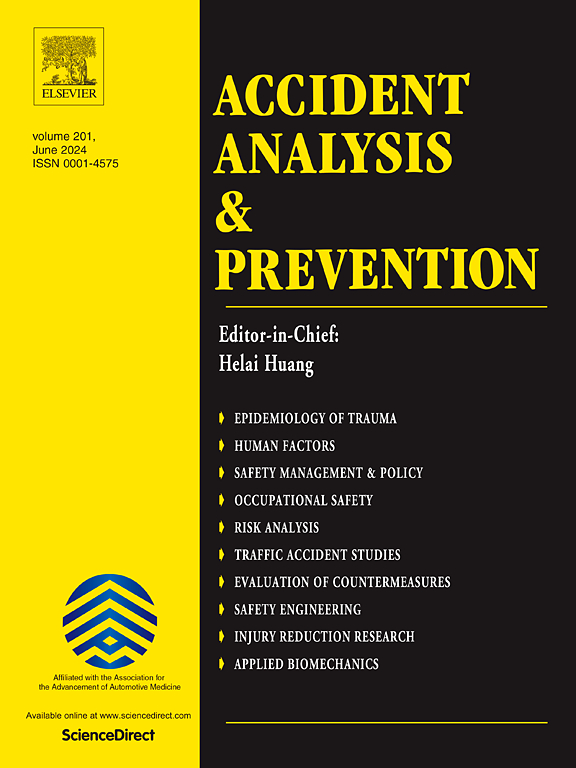Risk quantification based Adaptive Cruise control and its application in approaching behavior at signalized intersections
IF 5.7
1区 工程技术
Q1 ERGONOMICS
引用次数: 0
Abstract
Traffic signals, while reducing conflicts within intersections, often lead to stop-and-go behaviors in approaching vehicles, negatively impacting traffic flow in terms of safety, efficiency, and fuel consumption. Aimed at minimizing the traffic oscillations caused by traffic signals through Connected and Autonomous Vehicles (CAVs) and meeting real-time operational needs, this paper proposes a Risk-Based Adaptive Cruise Control (RACC). RACC designs the constraints of approaching a signalized intersection as expected risks, enabling compliance with all constraints while being adaptable to basic road scenarios. Theoretical analysis indicates that RACC, under specific parameter conditions, achieves string stability and overdamped characteristics while maintaining high throughput efficiency. Simulations confirm RACC’s sensitivity to risks, allowing it to timely adjust to return to a stable state, thus ensuring platoon safety under high throughput conditions. At signalized intersections, RACC enables CAVs to cross stop lines with smooth trajectories, significantly reducing risk, delays, and fuel consumption for all downstream vehicles. Further simulations demonstrate that RACC significantly reduces average travel time delay and fuel consumption across various traffic volumes and Market Penetration Rates (MPRs), with reductions of up to 87.1% in delays and 54.8% in fuel consumption, showcasing substantial computational efficiency improvements over benchmarks. Furthermore, extending this study to scenarios with higher traffic conflicts, such as multi-lane roads or intersections, while considering the impact of lane-changing behavior, is a promising direction for future research.
基于风险量化的自适应巡航控制及其在信号交叉口接近行为中的应用。
交通信号在减少交叉路口冲突的同时,往往会导致驶近车辆的走走停停行为,在安全、效率和燃油消耗方面对交通流量产生负面影响。为了最大限度地减少交通信号引起的交通波动,满足实时运行需求,提出了一种基于风险的自适应巡航控制(RACC)。RACC将接近信号交叉口的约束设计为预期风险,在适应基本道路场景的同时,能够遵守所有约束。理论分析表明,在特定参数条件下,RACC能够在保持较高吞吐效率的同时,实现管柱稳定性和过阻尼特性。仿真证实了RACC对风险的敏感性,使其能够及时调整以返回稳定状态,从而确保高吞吐量条件下的排安全。在有信号的十字路口,RACC使自动驾驶汽车能够以平稳的轨迹越过停车线,大大降低了所有下游车辆的风险、延误和油耗。进一步的模拟表明,RACC显著降低了不同交通量和市场渗透率(mpr)的平均出行时间延迟和燃油消耗,延迟减少了87.1%,燃油消耗减少了54.8%,与基准相比,计算效率有了实质性的提高。此外,将本研究扩展到交通冲突较高的场景,如多车道道路或交叉路口,同时考虑变道行为的影响,是未来研究的一个有希望的方向。
本文章由计算机程序翻译,如有差异,请以英文原文为准。
求助全文
约1分钟内获得全文
求助全文
来源期刊

Accident; analysis and prevention
Multiple-
CiteScore
11.90
自引率
16.90%
发文量
264
审稿时长
48 days
期刊介绍:
Accident Analysis & Prevention provides wide coverage of the general areas relating to accidental injury and damage, including the pre-injury and immediate post-injury phases. Published papers deal with medical, legal, economic, educational, behavioral, theoretical or empirical aspects of transportation accidents, as well as with accidents at other sites. Selected topics within the scope of the Journal may include: studies of human, environmental and vehicular factors influencing the occurrence, type and severity of accidents and injury; the design, implementation and evaluation of countermeasures; biomechanics of impact and human tolerance limits to injury; modelling and statistical analysis of accident data; policy, planning and decision-making in safety.
 求助内容:
求助内容: 应助结果提醒方式:
应助结果提醒方式:


